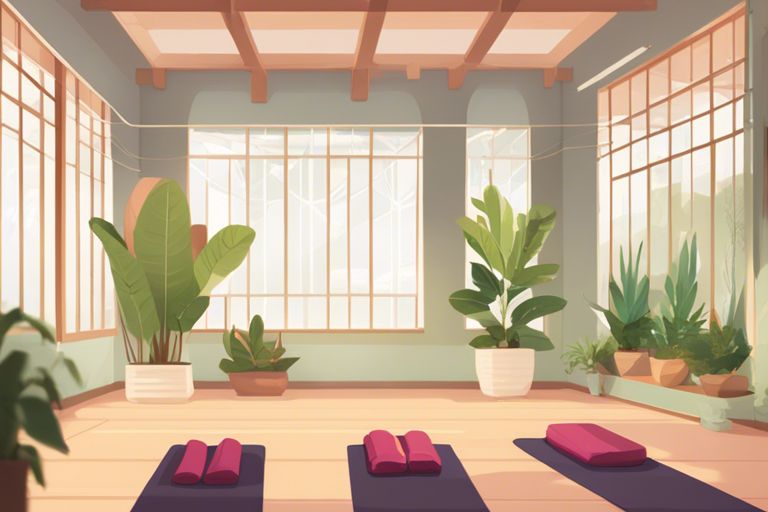There’s nothing quite like designing your own yoga workout routine tailored to your needs and preferences. In this guide, you will discover how to create a customized yoga practice that fits your schedule, goals, and skill level. With effective tips and strategies, you can maximize the benefits of yoga while enjoying your journey to a healthier mind and body.
Key Takeaways:
- Variety is key: Incorporate a mix of poses, stretches, and breathing exercises to target different areas of the body and provide a well-rounded practice.
- Listen to your body: Pay attention to how each pose feels and make adjustments as needed to prevent injury and ensure a safe and effective workout.
- Set goals and track progress: Establish specific goals for your yoga practice, such as improving flexibility or building strength, and track your progress over time to stay motivated and accountable.
1. Determine your fitness level and yoga goals.
2. Select yoga poses for flexibility, strength, and relaxation.
3. Start with a gentle warm-up to prepare your body.
4. Sequence poses logically to flow smoothly.
5. Incorporate breathing exercises for mindfulness and relaxation.
6. Cool down with gentle stretches and relaxation poses.

Understanding the Types of Yoga
While initiateing on creating your own yoga workout routine, it is vital to understand the different types of yoga practices available. Here are some common types of yoga that you can explore:
- Hatha Yoga: Hatha yoga is a gentle and slow-paced practice that focuses on basic poses and breathing techniques. It is a great starting point for beginners as it helps build a strong foundation for your practice. Any yoga routine incorporating Hatha yoga will help you improve flexibility, balance, and strength.
- Vinyasa Yoga: Vinyasa yoga is more dynamic and fast-paced, linking breath with movement. There’s a focus on flowing from one pose to the next, creating a seamless sequence. This type of yoga is great for those looking for a more vigorous workout that also promotes mindfulness and relaxation.
Hatha Yoga
Any yoga routine incorporating Hatha yoga will help you improve flexibility, balance, and strength. Hatha yoga also places emphasis on aligning the body properly in each pose, which can help prevent injuries and promote overall well-being.
Vinyasa Yoga
There’s a focus on flowing from one pose to the next, creating a seamless sequence. Vinyasa yoga is excellent for enhancing cardiovascular health, building muscle strength, and improving flexibility. The continuous movement in Vinyasa yoga can also help you cultivate a sense of mindfulness and presence on the mat.
Ashtanga Yoga
Types of poses in Ashtanga yoga are performed in a specific sequence to create heat in the body and build strength. Ashtanga yoga is a physically demanding practice that focuses on synchronizing breath with movement. Understanding the proper alignment and transitions between poses is crucial in Ashtanga yoga to prevent injuries and progress in your practice.
Restorative Yoga
One of the key benefits of restorative yoga is its ability to promote relaxation and reduce stress. Restorative yoga involves holding passive poses for an extended period, allowing the body to release tension and deeply relax. This type of practice is ideal for those looking to unwind and restore balance to their bodies and minds.
Yin Yoga
To get the most out of your yin yoga practice, it is important to hold poses for an extended period, typically between 3 to 5 minutes. Yin yoga targets the connective tissues, such as ligaments and fascia, helping to improve flexibility and joint mobility. Yoga poses in Yin yoga are often passive and seated, focusing on relaxation and deep stretching.
In your yoga workout routine, consider incorporating a variety of yoga types to experience a well-rounded practice that caters to your physical and mental well-being. Remember to listen to your body and choose yoga styles that align with your goals and preferences.

Factors to Consider When Creating Your Own Yoga Workout Routine
For creating your own yoga workout routine, there are several important factors to consider to ensure that you develop a plan that suits your needs and goals. Knowing these factors will help you tailor your routine to fit your lifestyle and preferences, ultimately leading to a more enjoyable and effective yoga practice.
Setting Goals and Objectives
Objectives: Start by clearly defining your goals and objectives for starting a yoga practice. Think about what you want to achieve through yoga, whether it’s improving flexibility, reducing stress, or increasing strength. By setting specific goals, you can create a yoga routine that is targeted towards achieving your desired outcomes.
Assessing Your Current Fitness Level
One: Before you design a yoga routine, it’s important to assess your current fitness level. This will help you determine the appropriate intensity and duration of your practice. If you are new to yoga, consider starting with beginner-friendly poses and gradually increasing the difficulty as you build strength and flexibility.
Considering Your Lifestyle and Schedule
Lifestyle: Assessing your lifestyle and schedule is crucial when creating a yoga routine. Take into account how much time you can realistically dedicate to yoga each week and choose a practice that fits seamlessly into your daily routine. Whether you prefer morning energizing sessions or relaxing evening practices, make sure your routine aligns with your lifestyle.
Identifying Your Preferred Yoga Style
Routine: When identifying your preferred yoga style, consider what type of practice resonates most with you. Whether you enjoy the flowing movements of Vinyasa or the precise alignment of Iyengar, choosing a style that you love will help maintain your motivation and commitment to yoga. Level up your practice by experimenting with different styles to find the one that best suits your preferences.
Step-By-Step Guide to Creating Your Own Yoga Workout Routine
Despite the availability of pre-made yoga sequences, creating your own routine can be a rewarding experience tailored to your specific needs and preferences. If you’re wondering how to get started, check out this How Can I Create My Own Yoga Sequences? guide for inspiration.
Defining Your Practice Space
| Step | Details |
| 1 | Designate a quiet and clutter-free area in your home for your practice. |
| 2 | Personalize the space with items that inspire you, such as candles or plants. |
Choosing the Right Equipment and Props
For a successful yoga practice, it’s vital to have the right equipment and props that support your poses and enhance your experience.
Another consideration is investing in quality yoga mats, blocks, straps, and bolsters that can assist you in achieving proper alignment and comfort during your practice.
Selecting the Right Music and Ambiance
While creating your yoga routine, consider the music and ambiance that will help you get into the right mindset and flow smoothly through your sequence.
Your choice of music, whether calming instrumental tunes or uplifting beats, can greatly impact your energy levels and focus during your practice.
Creating a Balanced Sequence of Poses
Choosing a balance of poses that target different areas of your body and provide a mix of strength, flexibility, and relaxation is crucial for a well-rounded practice.
Creating a sequence that flows smoothly from one pose to the next, gradually warming up your body and cooling down towards the end, will help you achieve a holistic yoga workout.

Essential Tips for a Safe and Effective Yoga Practice
Now, when creating your own yoga workout routine, it’s crucial to keep in mind some necessary tips for a safe and effective practice. By listening to your body and honoring its limits, you can prevent injuries and make progress at your own pace.
Listening to Your Body and Honoring Its Limits
Honoring your body means paying attention to how you feel during each pose and making adjustments as needed. If you experience pain or discomfort, it’s important to back off and modify the pose to a more comfortable position. Pushing yourself too hard can lead to injuries, so always listen to your body’s signals and respect its boundaries. This self-awareness will not only keep you safe but also help you progress in your practice over time.
Breathing Techniques and Proper Alignment
Even as you move through your yoga routine, remember to focus on your breathing techniques and proper alignment. Your breath should be steady and controlled, helping you relax into each pose and maintain stability. Proper alignment is key to prevent strain on your muscles and joints, ensuring a safe and effective practice.
The breath is a vital component of yoga practice, as it not only oxygenates your body but also calms your mind. By syncing your movements with your breath and focusing on proper alignment, you can deepen your practice and maximize its benefits.
Modifying Poses for Injury Prevention
Breathing through each pose, modify them as needed to prevent injuries. If you have a specific injury or limitation, adapt the pose to suit your body’s needs. Avoid pushing yourself into positions that cause pain or discomfort, as this can lead to more serious injuries over time.
Poses that are too advanced or intense for your current level of flexibility or strength can put you at risk of injury. It’s important to respect your body’s limitations and progress gradually to avoid overstraining your muscles or joints. By modifying poses and listening to your body, you can stay safe and enjoy the benefits of your yoga practice.
Practicing Mindfulness and Meditation
Safe practicing mindfulness and meditation can enhance your yoga experience and promote mental well-being. Incorporating moments of stillness and focus into your practice can help you connect with your inner self and cultivate a sense of peace and clarity.
Prevention
- Not only does mindfulness improve your overall well-being
- but it also enhances your physical performance on the mat. By staying present and focused during your practice, you can deepen your mind-body connection and experience yoga as a moving meditation.
Pros and Cons of Creating Your Own Yoga Workout Routine
| Pros | Cons |
| Customization and Personalization | Potential for Injury or Burnout |
| Increased Motivation and Accountability | Lack of Guidance and Feedback |
Customization and Personalization
If you choose to create your own yoga workout routine, you have the freedom to customize it according to your preferences and fitness goals. This allows you to tailor the routine to focus on specific areas of your body or types of yoga practices that resonate with you. Customizing your routine can make your practice more enjoyable and effective as it caters to your individual needs.
Increased Motivation and Accountability
If you are someone who thrives on setting goals and challenges for yourself, creating your own yoga workout routine can significantly boost your motivation and accountability. You are responsible for planning and following through with your practice, which can give you a sense of accomplishment and drive to stick to your routine. Additionally, tracking your progress and improvements over time can be gratifying.
With Increased Motivation and Accountability, you are more likely to stay committed to your practice and see results as you strive to meet your set goals. By taking charge of your yoga routine, you can create a sense of ownership and empowerment in your practice.
Potential for Injury or Burnout
Some risks come with creating your own yoga workout routine, such as the potential for injury or burnout. Without professional guidance, you may unknowingly perform poses incorrectly, leading to strains or injuries. Overdoing certain poses or not incorporating enough rest into your routine can also result in burnout or fatigue. It’s important to listen to your body and practice mindfully to avoid these risks.
Motivation is key to achieving your fitness goals, and creating your own yoga workout routine allows you to stay motivated by setting personalized milestones and challenges. However, it’s crucial to balance motivation with self-awareness to prevent pushing yourself too hard and risking injury.
Lack of Guidance and Feedback
If you decide to create your own yoga workout routine, you may face challenges due to the lack of professional guidance and feedback. A certified yoga instructor can provide valuable insights, corrections, and adjustments to improve your practice. Without this guidance, you may develop bad habits or plateau in your progress. Seeking feedback from experienced practitioners or attending occasional yoga classes can help you refine your routine and avoid potential pitfalls.
Tips for Staying Motivated and Consistent
Once again, staying motivated and consistent with your yoga workout routine is vital for seeing progress and reaping the full benefits of the practice. Here are some tips to help you stay on track:
Creating a Schedule and Sticking to It
There’s no denying that life can get busy, but if you prioritize your yoga practice by scheduling it into your day, you are more likely to stick to it. Whether it’s early morning, lunchtime, or before bed, find a time that works best for you and make it a non-negotiable part of your day. This commitment will help you build consistency and make your practice a habit.
Finding a Yoga Buddy or Community
Tips for finding a yoga buddy or community to support your practice can make a significant difference in your motivation levels. Having someone to hold you accountable, share experiences with, and provide encouragement can keep you inspired and committed to your routine.
With a yoga buddy or community, you can join classes together, set common goals, and celebrate achievements as a group. This shared experience can create a sense of belonging and make your yoga journey more enjoyable and fulfilling.
Tracking Progress and Celebrating Milestones
Sticking to your yoga routine becomes easier when you track your progress and celebrate your milestones along the way. Keep a journal or use a tracking app to monitor your practice, note any improvements in your strength or flexibility, and celebrate small victories. This positive reinforcement will motivate you to continue and challenge yourself further.
This approach also helps you identify areas for growth, set new goals, and stay engaged in your practice. Bear in mind, progress is a process, and every step forward is worth acknowledging and celebrating.
Continuously Challenging Yourself and Trying New Things
Continuously challenging yourself in your yoga practice and trying new things is crucial for preventing plateaus and keeping your workouts exciting. Explore different yoga styles, attend workshops or retreats, or set personal challenges to push yourself out of your comfort zone. This exploration can help you discover new abilities, overcome fears, and grow both physically and mentally.
Community support can play a significant role in motivating you to step outside your comfort zone and try new things. Engaging with like-minded individuals, seeking inspiration from experienced practitioners, and sharing your journey can empower you to embrace change and expand your practice in ways you never thought possible.
To wrap up
With this in mind, creating your own yoga workout routine can be a freeing and personalized experience that helps you tailor your practice to your specific needs and goals. By following these effective how-to tips, you can design a sequence that addresses your body’s unique requirements, challenges, and aspirations. Recall, your routine doesn’t have to be rigid or follow a set structure – feel free to experiment, evolve, and adapt it as you progress in your practice.
For more detailed guidance on how to create a yoga sequence, you can refer to this helpful resource on How to Create A Yoga Sequence. Keep exploring, challenging yourself, and enjoying the journey as you craft a yoga workout routine that truly resonates with you.
FAQ
Q: Why is it important to create my own yoga workout routine?
A: Creating your own yoga workout routine allows you to tailor the practice to your specific needs, preferences, and goals. It helps you focus on areas that require attention, such as flexibility, strength, or relaxation.
Q: How can I start creating my own yoga workout routine?
A: Begin by identifying your objectives and selecting poses that align with them. Consider factors like duration, intensity, and frequency. Gradually build a routine that challenges you while also being realistic and enjoyable.
Q: What are some tips for maintaining a consistent yoga practice?
A: Set specific goals, schedule regular practice sessions, and track your progress. Listen to your body, adapt the routine as needed, and incorporate variety to keep it engaging. Consider seeking guidance from a yoga instructor to refine your routine further.











